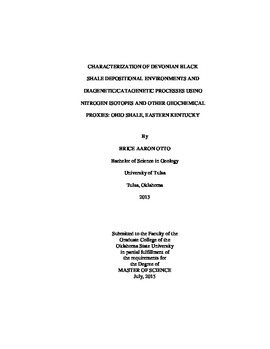| dc.contributor.advisor | Quan, Tracy M. | |
| dc.contributor.author | Otto, Brice Aaron | |
| dc.date.accessioned | 2016-09-29T18:42:08Z | |
| dc.date.available | 2016-09-29T18:42:08Z | |
| dc.date.issued | 2015-07-01 | |
| dc.identifier.uri | https://hdl.handle.net/11244/45294 | |
| dc.description.abstract | Research investigating catagenetic alterations of ?15Nbulk values in Devonian shales have shown little correlation between ?15Nbulk profiles and thermal maturities; instead it was concluded that ?15Nbulk values primarily reflect the paleoredox conditions during deposition. Separating inorganic nitrogen (IN) from bulk nitrogen has proven useful to be a useful proxy for characterizing catagenetic alterations because IN, in the form of NH4+, is released from organic matter (OM) during thermal degradation and fixed by surrounding authigenic clays. Conceptually, three scenarios can exist between bulk and inorganic nitrogen isotopic values at a particular depth: (1) ?15Nbulk > ?15Ninorg (positive); (2) ?15Nbulk < ?15Ninorg (negative); or (3) ?15Nbulk ? ?15Ninorg (closed). Along with characterizing the paleoredox conditions of the Ohio Shale, our research will also evaluate the driving mechanism responsible for these relationships between ?15Ninorg and the original paleoredox-dependent ?15Nbulk value. Using ?15Nbulk and TOC as our proxies for oxygen content and preservation of OM, it is possible to evaluate the paleoredox evolution during Ohio Shale deposition at the A. Lowe Heirs KL4-504695 in Pike County, Kentucky. The lower and upper Huron were deposited in predominantly anoxic conditions under the pycnocline, while the middle Huron was deposited under alternating suboxic and anoxic conditions. The Chagrin was predominantly deposited in a suboxic environment within the pycnocline. The Cleveland equivalent was deposited proximal to upwelling conditions but not within the oxygen minimum zone. The relationship between ?15Nbulk and ?15Ninorganic values is dependent on paleoredox conditions, clay contents, degradation-recondensation processes, and diagenetic and catagenetic processes. Negative crossover profiles, associated with anoxic intervals, suggests that isotopic buffering is occurring along with an observed inversion of normal fractionation kinetics during thermal degradation of OM, and the preferential uptake of heavy 15NH4+ by authigenic clays. Positive crossover profiles, associated with suboxic conditions, suggest that normal isotopic fractionation kinetics prevails, releasing isotopically light 14NH4+ during the thermal degradation of OM. Closed intervals are indicative of compartmentalization and isotopic equilibrium exchange between stationary OM and circulating NH4+ pools. | |
| dc.format | application/pdf | |
| dc.language | en_US | |
| dc.rights | Copyright is held by the author who has granted the Oklahoma State University Library the non-exclusive right to share this material in its institutional repository. Contact Digital Library Services at lib-dls@okstate.edu or 405-744-9161 for the permission policy on the use, reproduction or distribution of this material. | |
| dc.title | Characterization of Devonian Black Shale Depositional Environments and Diagenetic/catagenetic Processes Using Nitrogen Isotopes and Other Geochemical Proxies: Ohio Shale, Eastern Kentucky | |
| dc.type | text | |
| dc.contributor.committeeMember | Puckette, James | |
| dc.contributor.committeeMember | Pashin, Jack | |
| osu.filename | Otto_okstate_0664M_14074.pdf | |
| osu.accesstype | Open Access | |
| dc.description.department | Geology | |
| dc.type.genre | Thesis | |
